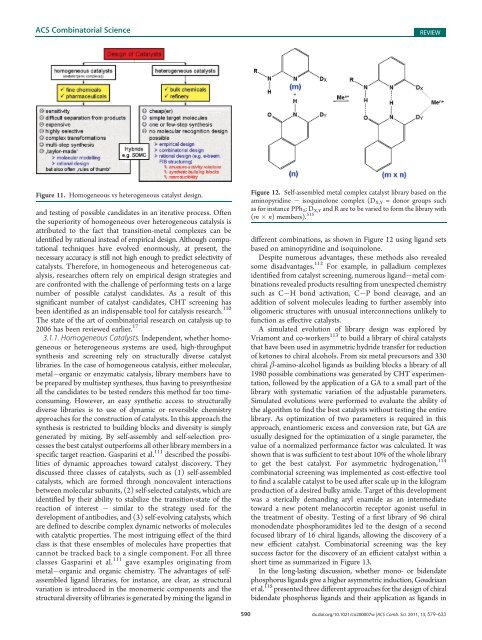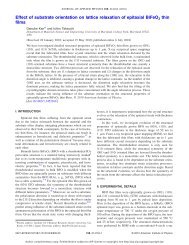Combinatorial and High-Throughput Screening of Materials ...
Combinatorial and High-Throughput Screening of Materials ...
Combinatorial and High-Throughput Screening of Materials ...
Create successful ePaper yourself
Turn your PDF publications into a flip-book with our unique Google optimized e-Paper software.
ACS <strong>Combinatorial</strong> Science<br />
REVIEW<br />
Figure 11. Homogeneous vs heterogeneous catalyst design.<br />
<strong>and</strong> testing <strong>of</strong> possible c<strong>and</strong>idates in an iterative process. Often<br />
the superiority <strong>of</strong> homogeneous over heterogeneous catalysis is<br />
attributed to the fact that transition-metal complexes can be<br />
identified by rational instead <strong>of</strong> empirical design. Although computational<br />
techniques have evolved enormously, at present, the<br />
necessary accuracy is still not high enough to predict selectivity <strong>of</strong><br />
catalysts. Therefore, in homogeneous <strong>and</strong> heterogeneous catalysis,<br />
researches <strong>of</strong>tern rely on empirical design strategies <strong>and</strong><br />
are confronted with the challenge <strong>of</strong> performing tests on a large<br />
number <strong>of</strong> possible catalyst c<strong>and</strong>idates. As a result <strong>of</strong> this<br />
significant number <strong>of</strong> catalyst c<strong>and</strong>idates, CHT screening has<br />
been identified as an indispensable tool for catalysis research. 110<br />
The state <strong>of</strong> the art <strong>of</strong> combinatorial research on catalysis up to<br />
2006 has been reviewed earlier. 17<br />
3.1.1. Homogeneous Catalysts. Independent, whether homogeneous<br />
or heterogeneous systems are used, high-throughput<br />
synthesis <strong>and</strong> screening rely on structurally diverse catalyst<br />
libraries. In the case <strong>of</strong> homogeneous catalysis, either molecular,<br />
metal organic or enzymatic catalysis, library members have to<br />
be prepared by multistep syntheses, thus having to presynthesize<br />
all the c<strong>and</strong>idates to be tested renders this method far too timeconsuming.<br />
However, an easy synthetic access to structurally<br />
diverse libraries is to use <strong>of</strong> dynamic or reversible chemistry<br />
approaches for the construction <strong>of</strong> catalysts. In this approach the<br />
synthesis is restricted to building blocks <strong>and</strong> diversity is simply<br />
generated by mixing. By self-assembly <strong>and</strong> self-selection processes<br />
the best catalyst outperforms all other library members in a<br />
specific target reaction. Gasparini et al. 111 described the possibilities<br />
<strong>of</strong> dynamic approaches toward catalyst discovery. They<br />
discussed three classes <strong>of</strong> catalysts, such as (1) self-assembled<br />
catalysts, which are formed through noncovalent interactions<br />
between molecular subunits, (2) self-selected catalysts, which are<br />
identified by their ability to stabilize the transition-state <strong>of</strong> the<br />
reaction <strong>of</strong> interest similar to the strategy used for the<br />
development <strong>of</strong> antibodies, <strong>and</strong> (3) self-evolving catalysts, which<br />
are defined to describe complex dynamic networks <strong>of</strong> molecules<br />
with catalytic properties. The most intriguing effect <strong>of</strong> the third<br />
class is that these ensembles <strong>of</strong> molecules have properties that<br />
cannot be tracked back to a single component. For all three<br />
classes Gasparini et al. 111 gave examples originating from<br />
metal organic <strong>and</strong> organic chemistry. The advantages <strong>of</strong> selfassembled<br />
lig<strong>and</strong> libraries, for instance, are clear, as structural<br />
variation is introduced in the monomeric components <strong>and</strong> the<br />
structural diversity <strong>of</strong> libraries is generated by mixing the lig<strong>and</strong> in<br />
Figure 12. Self-assembled metal complex catalyst library based on the<br />
aminopyridine isoquinolone complex (D X,Y = donor groups such<br />
as for instance PPh 2 ;D X,Y <strong>and</strong> R are to be varied to form the library with<br />
(m n) members). 515<br />
different combinations, as shown in Figure 12 using lig<strong>and</strong> sets<br />
based on aminopyridine <strong>and</strong> isoquinolone.<br />
Despite numerous advantages, these methods also revealed<br />
some disadvantages. 112 For example, in palladium complexes<br />
identified from catalyst screening, numerous lig<strong>and</strong> metal combinations<br />
revealed products resulting from unexpected chemistry<br />
such as C H bond activation, C P bond cleavage, <strong>and</strong> an<br />
addition <strong>of</strong> solvent molecules leading to further assembly into<br />
oligomeric structures with unusual interconnections unlikely to<br />
function as effective catalysts.<br />
A simulated evolution <strong>of</strong> library design was explored by<br />
Vriamont <strong>and</strong> co-workers 113 to build a library <strong>of</strong> chiral catalysts<br />
that have been used in asymmetric hydride transfer for reduction<br />
<strong>of</strong> ketones to chiral alcohols. From six metal precursors <strong>and</strong> 330<br />
chiral β-amino-alcohol lig<strong>and</strong>s as building blocks a library <strong>of</strong> all<br />
1980 possible combinations was generated by CHT experimentation,<br />
followed by the application <strong>of</strong> a GA to a small part <strong>of</strong> the<br />
library with systematic variation <strong>of</strong> the adjustable parameters.<br />
Simulated evolutions were performed to evaluate the ability <strong>of</strong><br />
the algorithm to find the best catalysts without testing the entire<br />
library. As optimization <strong>of</strong> two parameters is required in this<br />
approach, enantiomeric excess <strong>and</strong> conversion rate, but GA are<br />
usually designed for the optimization <strong>of</strong> a single parameter, the<br />
value <strong>of</strong> a normalized performance factor was calculated. It was<br />
shown that is was sufficient to test about 10% <strong>of</strong> the whole library<br />
to get the best catalyst. For asymmetric hydrogenation, 114<br />
combinatorial screening was implemented as cost-effective tool<br />
to find a scalable catalyst to be used after scale up in the kilogram<br />
production <strong>of</strong> a desired bulky amide. Target <strong>of</strong> this development<br />
was a sterically dem<strong>and</strong>ing aryl enamide as an intermediate<br />
toward a new potent melanocortin receptor agonist useful in<br />
the treatment <strong>of</strong> obesity. Testing <strong>of</strong> a first library <strong>of</strong> 96 chiral<br />
monodendate phosphoramidites led to the design <strong>of</strong> a second<br />
focused library <strong>of</strong> 16 chiral lig<strong>and</strong>s, allowing the discovery <strong>of</strong> a<br />
new efficient catalyst. <strong>Combinatorial</strong> screening was the key<br />
success factor for the discovery <strong>of</strong> an efficient catalyst within a<br />
short time as summarized in Figure 13.<br />
In the long-lasting discussion, whether mono- or bidendate<br />
phosphorus lig<strong>and</strong>s give a higher asymmetric induction, Goudriaan<br />
et al. 115 presented three different approaches for the design <strong>of</strong> chiral<br />
bidendate phosphorus lig<strong>and</strong>s <strong>and</strong> their application as lig<strong>and</strong>s in<br />
590 dx.doi.org/10.1021/co200007w |ACS Comb. Sci. 2011, 13, 579–633












